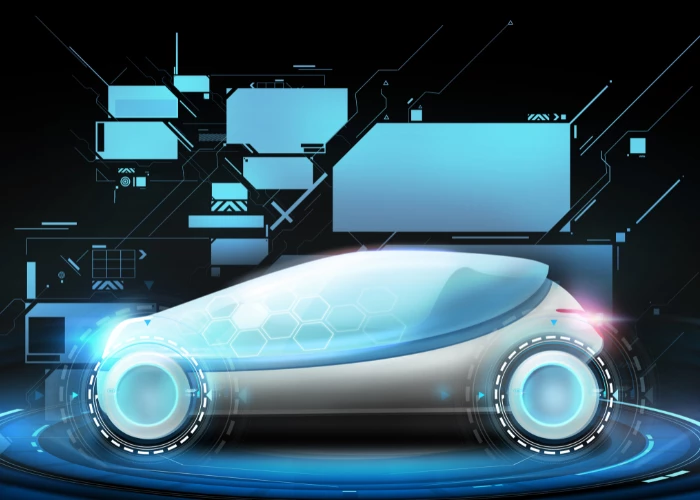As manufacturers pack vehicles with more complex safety systems and rollout sophisticated electrified platforms, computational power is rapidly displacing horsepower as a measure of performance.
Modern passenger car E/E systems can call for up to 100 million lines of code – five times that used in an F35 fighter jet.
This embedded software that typically executes on between 70 to 100 microprocessor-based electronic control units, can consume up to 13 percent of the overall development time of a new vehicle.
Image Source: IEEE Spectrum [PDF in German]
The increase in the number of software-driven systems that require significant development and testing times, and escalate costs, have forced the industry into a paradigm shift toward model-based systems engineering.
The Model-Based Design (MBD) paradigm is significantly different from traditional design methodology. Instead of using complex structures and extensive software code, designers now use model-based systems to define plant models (the combination of process and actuator) with advanced functional characteristics using continuous-time and discrete-time building blocks.
Model-based systems engineering delivers futuristic automotive products at reduced time-to-market and costs
The need to shift to Model-Based Development primarily stems from the inherent complexity that the manual coding process brings about during development. Not only the size of the code, but the complex application of the code also makes it quite difficult to maintain the functional structure of the overall system software.
In manual coding, the software developer is more focused on the code instead of the function. Furthermore, large code bases are also very difficult to port to other microcontrollers, if the need for hardware platform migration arises.
Hence, the biggest challenge faced by software engineers while working on these complex systems is to shorten development cycles and reduce development and testing time, while ensuring system integrity.
MBD models, when used with simulation tools, enable rapid prototyping, software testing, and verification. Not only is the testing and verification process enhanced, but also, in some cases, hardware-in-the-loop simulation can be used with the new design model to perform testing of dynamic effects on the system more quickly and much more efficiently than with traditional software design methodology.
According to a joint global study by Altran Technologies and the chair of information management at the University of Technology in Munich, applying Model-Based Development can realize average cost savings of between 25 to 30 percent and time savings of 35 to 40 percent.
Moreover, applying Model-Based System Engineering (MBSE) provides opportunities to capture and harmonize information from multiple disciplines within an integrated digital model of the system. Since dependencies across multiple disciplines are explicitly addressed in the model, a change made in one area is automatically carried across to all the related software subsystems.
This feature makes it possible to maintain consistent and up-to-date information in the integrated digital model. In addition, completeness, consistency, traceability and contradiction checks can be performed, while the ability of MBSE to identify defects early in the system lifecycle also results in significant cost savings.
Image Source: University of Southern California (A M. Madni, S Purohit) [PDF download]
The ability of MBSE to exploit legacy models and data, further contributes to the economic justification of switching to model based systems. Since individual projects may not have the luxury of time to work on data reuse, additional measures would normally be required at the enterprise management level to incentivize projects to achieve this reuse.
Also, with increasing system complexity effective risk management is a significant advantage of model-based systems. With centralized digital repositories and data analysis capability, MBSE promises to increase communication efficiency and reduce feedback loops, thereby significantly reducing risk during the system lifecycle.
Although MBSE provides cost savings through quick traceability mechanisms that are built into the modern modeling environments, the ever-increasing complexity of systems in multiple domains makes it ever-more difficult to conform to standards.
This is well illustrated in the rapidly developing field of automated driving, where model-based systems play a vital role in the safe and effective development of both the system hardware and software.
Could the digital twin concept be the next step in MBSE software system design?
Digital twin, a concept introduced in 2002, is becoming increasingly relevant in systems engineering and, more specifically, in MBSE. A digital twin, like a virtual prototype, is a dynamic digital representation of a physical system. However, unlike a virtual prototype, a digital twin is a virtual instance of a physical system (twin) that is continually updated with the latter’s performance, maintenance, and health status data throughout the physical system’s lifecycle.
The context of operation of the digital twin involves an instrumented testbed in which MBSE system modeling and verification tools and operational scenario simulations (e.g. discrete event simulations, agent-based simulations) are used to explore the behavior of virtual prototypes in a what-if simulation mode under the control of the experimenter.
Insights from the operational environment are used to modify the system models used in the virtual prototype. Data supplied by the physical system is used by the virtual prototype to instantly update the digital twin on an ongoing basis, so it faithfully mirrors the characteristics and history of the physical twin.
Image source: Intelligent Systems Technology
As shown in this figure, the digital twin links the virtual and physical environments.
The physical environment includes the physical system, onboard and external sensors, communication interfaces, and possibly other vehicles operating in an open environment with access to GPS data. Both operational and maintenance data associated with the physical system are supplied to the virtual environment to update the virtual model in the digital twin. Thus, the digital twin becomes a precise and up-to-date representation of a physical system that also reflects the operational context of the physical twin.
Importantly, the relationship with the physical twin can continue even after the sale of the physical twin, thereby making it possible to track the performance and maintenance history of each physical twin over time, detect and report anomalous behavior, and recommend or schedule maintenance.
A good example of this is Tesla’s Autopilot that collects vast amounts of real-world data from its fleet of vehicles which is then used to update the software algorithms for future OTA updates.
With the benefits of model-based development of complex systems in the automotive domain already paying dividends MBES is rapidly being rolled out by the main players in the automotive industry.
As of now, 16 percent of the SLOC (number of lines of code) in a car are generated from models. This number is growing rapidly as OEMs race against one another to introduce new safety and infotainment features while increasing electrification to meet emissions targets.
That means as autonomous self-driving vehicles evolve, the demand for cost effective model-based systems engineering is set to become the norm in most E/E systems.

























